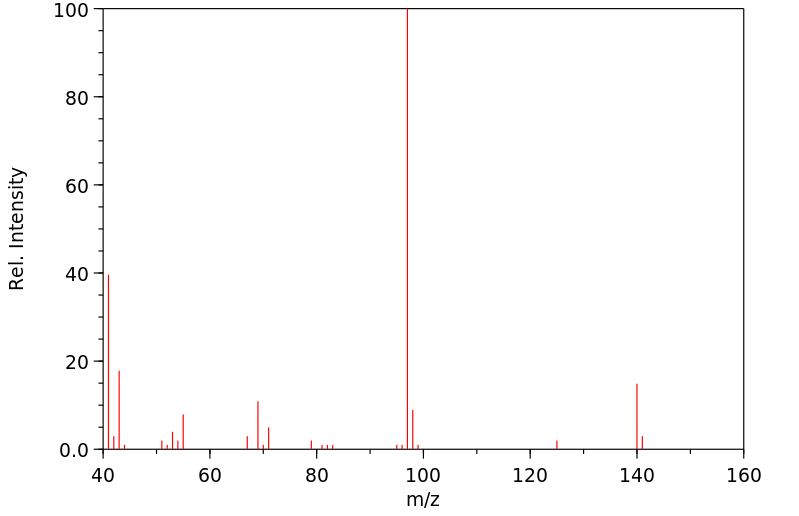2,6-dimethyl-hept-4t-en-3-one | 18402-85-2
中文名称
——
中文别名
——
英文名称
2,6-dimethyl-hept-4t-en-3-one
英文别名
2,6-dimethyl-hept-4-en-3-one;α.α-Dimethyl-α'-isobutyliden-aceton;2.6-Dimethyl-hepren-(3)-on-(5);2,6-Dimethyl-hept-4-en-3-on;4-Hepten-3-one, 2,6-dimethyl-;(E)-2,6-dimethylhept-4-en-3-one
CAS
18402-85-2
化学式
C9H16O
mdl
——
分子量
140.225
InChiKey
FXHCGFPVKLZHCE-AATRIKPKSA-N
BEILSTEIN
——
EINECS
——
-
物化性质
-
计算性质
-
ADMET
-
安全信息
-
SDS
-
制备方法与用途
-
上下游信息
-
文献信息
-
表征谱图
-
同类化合物
-
相关功能分类
-
相关结构分类
计算性质
-
辛醇/水分配系数(LogP):2.6
-
重原子数:10
-
可旋转键数:3
-
环数:0.0
-
sp3杂化的碳原子比例:0.67
-
拓扑面积:17.1
-
氢给体数:0
-
氢受体数:1
反应信息
-
作为反应物:描述:2,6-dimethyl-hept-4t-en-3-one 在 sodium amide 、 三乙胺 、 sodium iodide 作用下, 以 四氢呋喃 、 二氯甲烷 、 乙腈 为溶剂, 反应 0.17h, 生成 2,8-dimethyl-5-isopropylidenenona-1,6-diene-3-yne参考文献:名称:高度取代的共轭三烯炔的通用和方便合成摘要:描述了一种方便合成高度取代的非线性共轭三烯炔。我们的策略涉及容易获得的硫代磷酸盐与二烯的钠衍生物的反应,其中形成新的单碳-碳键和双碳-碳键。DOI:10.1055/s-2003-38078
-
作为产物:描述:参考文献:名称:Grayson, David H.; Tuite, Mathew R. J., Journal of the Chemical Society. Perkin transactions I, 1986, p. 2137 - 2142摘要:DOI:
文献信息
-
KRAS G12C INHIBITORS AND METHODS OF USING THE SAME申请人:AMGEN INC.公开号:US20180177767A1公开(公告)日:2018-06-28Provided herein are KRAS G12C inhibitors, composition of the same, and methods of using the same. These inhibitors are useful for treating a number of disorders, including pancreatic, colorectal, and lung cancers.
-
DNA-BINDING POLYMERS申请人:Dervan Peter B.公开号:US20090155202A1公开(公告)日:2009-06-18Methods and compositions are provided for forming complexes between dsDNA and novel DNA-binding polymers comprising N-terminal thiophene-containing moieties which exhibit selectivity for T-A base pairs. By appropriate choice of target sequences and DNA-binding polymers, complexes comprising polymer-DNA are obtained with high association constants. The formation of complexes can be used for identification of specific dsDNA sequences, for inhibiting gene transcription, and as a therapeutic for inhibiting proliferation of undesired cells or modulation of expression of specific genes.
-
Intramolecular activation of aromatic C–H bonds at tantalum(V) metal centers: evaluating cyclometallation ‘resistant’ and ‘immune’ aryloxide ligation作者:Jonathan S. Vilardo、Mark A. Lockwood、Linda G. Hanson、Janet R. Clark、Bernardeta C. Parkin、Phillip E. Fanwick、Ian P. RothwellDOI:10.1039/a702325a日期:——The trichloride compounds [Ta(OC 6 HPh 2 -2,6-R 2 -3,5)Cl 3 ] (1: R = H a, Ph b, Me c, Pr i d or Bu t e) have been obtained by treating [Ta 2 Cl 10 ] with the corresponding 3,5-disubstituted-2,6-diphenylphenols IaâIe. The solid-state structures of 1c and 1d show a square-pyramidal structure with an axial aryloxide ligand. The reaction of 1 with LiCH 2 SiMe 3 (3 equivalents) led to the isolation of the tris(alkyls) [Ta(OC 6 HPh 2 -2,6-R 2 -3,5) 2 (CH 2 SiMe 3 ) 3 ] (4aâ4d) except in the case of the 3,5-di-tert-butyl derivative 1e which generated the alkylidene compound [Ta(OC 6 H 3 Ph 2 -2,6-Bu t -3,5) 2 (CHSiMe 3 )(CH 2 SiMe 3 )] 6e. The alkylidenes 6aâ6d can be produced by photolysis of the corresponding tris(alkyls) 4aâ4d. The alkylidenes 6aâ6d undergo intramolecular cyclometallation of the aryloxide ligand (addition of an aromatic CâH bond to the tantalum alkylidene) at a rate which is extremely dependent on the meta substituents on the phenoxide nucleus. Kinetic studies show that conversion of 6aâ6d into monometallated 7aâ7d is first order with the phenyl, methyl and isopropyl substituents slowing the ring closure down by factors of 20, 90 and 360 respectively. The tert-butyl substituent completely shuts down cyclometallation of the adjacent phenyl ring. It is argued that bulky substituents inhibit rotation of the ortho-phenyl ring into a conformation necessary for CâH bond activation. Structural analysis of the torsion angles between ortho-phenyl and phenoxy rings has been carried out. The use of 1 H NMR chemical shifts has been demonstrated to be a valuable tool to probe the average conformations adopted in solution.通过将[Ta 2 Cl 10 ]与相应的 3,5-二取代-2,6-二苯基酚 IaâIe 处理,得到了三氯化物[Ta(OC 6 HPh 2 -2,6-R 2 -3,5)Cl 3 ](1:R = H a、Ph b、Me c、Pr i d 或 Bu t e)。1c 和 1d 的固态结构显示出一种带有轴向芳氧基配体的方阵结构。1 与 LiCH 2 SiMe 3(3 个等价物)反应,分离出三(烷基)[Ta(OC 6 HPh 2 -2,6-R 2 -3,5) 2 (CH 2 SiMe 3 ) 3 ](4aâ4d),但 3,5-二叔丁基衍生物 1e 除外,它生成了亚烷基化合物 [Ta(OC 6 H 3 Ph 2 -2,6-Bu t -3,5) 2 (CHSiMe 3 )(CH 2 SiMe 3 )] 6e。6e.通过光解相应的三烷基 4aâ4d 可以制得亚烷基 6aâ6d。亚烷基 6aâ6d 会发生芳氧基配体的分子内环金属化反应(在钽亚烷基上添加一个芳香族 CâH 键),反应速度与氧化酚核上的元取代基密切相关。动力学研究表明,6aâ6d 转化为单金属化 7aâ7d 的过程是一阶的,苯基、甲基和异丙基取代基会使闭环速度分别减慢 20、90 和 360 倍。叔丁基取代基完全阻止了邻近苯基环的环金属化。有观点认为,笨重的取代基抑制了正苯基环旋转到 CâH 键活化所需的构象。研究人员对正苯基环和苯氧环之间的扭转角进行了结构分析,结果表明,使用 1 H NMR 化学位移是探测溶液中平均构象的重要工具。
-
Modulators of Cellular Adhesion申请人:Shen Wang公开号:US20110124625A1公开(公告)日:2011-05-26The present invention provides compounds having formula (I): and pharmaceutically acceptable derivatives thereof, wherein R 1 -R 4 , n, p, A, B, D, E, L and AR 1 are as described generally and in classes and subclasses herein, and additionally provides pharmaceutical compositions thereof, and methods for the use thereof for the treatment of disorders mediated by the CD11/CD18 family of cellular adhesion molecules (e.g., LFA-1).本发明提供了具有式(I)的化合物及其药学上可接受的衍生物,其中R1-R4、n、p、A、B、D、E、L和AR1如本文中一般和各类和子类中所述,并且还提供了其药物组成物以及使用它们治疗由CD11/CD18细胞粘附分子(例如LFA-1)介导的疾病的方法。
-
MODULATORS OF CELLULAR ADHESION申请人:SARcode Bioscience Inc.公开号:US20140051675A1公开(公告)日:2014-02-20The present invention provides compounds having formula (I): and pharmaceutically acceptable derivatives thereof, wherein R 1 -R 4 , n, p, A, B, D, E, L and AR 1 are as described generally and in classes and subclasses herein, and additionally provides pharmaceutical compositions thereof, and methods for the use thereof for the treatment of disorders mediated by the CD11/CD18 family of cellular adhesion molecules (e.g., LFA-1).本发明提供具有式(I)的化合物及其药学上可接受的衍生物,其中R1-R4、n、p、A、B、D、E、L和AR1的描述如本文中一般和各类和子类中所述,并且还提供了其药物组成物以及使用它们治疗由CD11/CD18细胞黏附分子(例如LFA-1)介导的疾病的方法。
表征谱图
-
氢谱1HNMR
-
质谱MS
-
碳谱13CNMR
-
红外IR
-
拉曼Raman
-
峰位数据
-
峰位匹配
-
表征信息
同类化合物
(反式)-4-壬烯醛
(s)-2,3-二羟基丙酸甲酯
([1-(甲氧基甲基)-1H-1,2,4-三唑-5-基](苯基)甲酮)
(Z)-4-辛烯醛
(S)-氨基甲酸酯β-D-O-葡糖醛酸
(S)-3-(((2,2-二氟-1-羟基-7-(甲基磺酰基)-2,3-二氢-1H-茚满-4-基)氧基)-5-氟苄腈
(R)-氨基甲酸酯β-D-O-葡糖醛酸
(5,5-二甲基-2-(哌啶-2-基)环己烷-1,3-二酮)
(2,5-二氟苯基)-4-哌啶基-甲酮
龙胆苦苷
龙胆二糖甲乙酮氰醇(P)
龙胆二糖丙酮氰醇(P)
龙胆三糖
龙涎酮
齐罗硅酮
齐留通beta-D-葡糖苷酸
鼠李糖
黑芥子苷单钾盐
黑海棉酸钠盐
黑木金合欢素
黑曲霉三糖
黑介子苷
黄尿酸8-O-葡糖苷
麻西那霉素II
麦迪霉素
麦芽糖脎
麦芽糖基海藻糖
麦芽糖1-磷酸酯
麦芽糖
麦芽四糖醇
麦芽四糖
麦芽十糖
麦芽六糖
麦芽五糖水合物
麦芽五糖
麦芽五糖
麦芽五糖
麦芽三糖醇
麦芽三糖
麦芽三糖
麦芽三塘水合
麦芽七糖水合物
麦芽七糖
麦法朵
麦可酚酸-酰基-Β-D-葡糖苷酸
麦利查咪
麝香酮
鹤草酚
鸢尾酚酮 3-C-beta-D-吡喃葡萄糖苷
鸡矢藤苷







